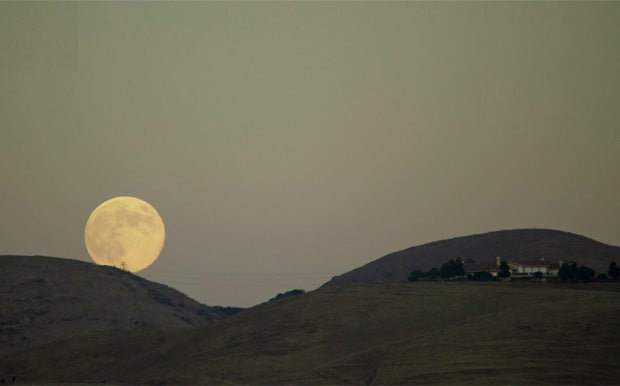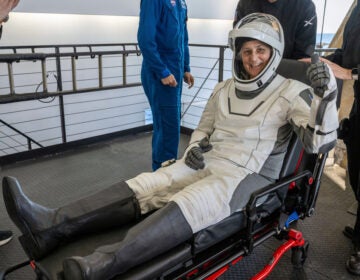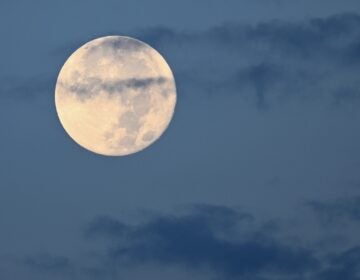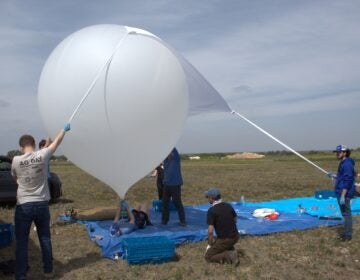Harvest Moon provides visual feast
ListenThursday’s full moon is the Harvest Moon, which is the full moon closest to the Autumnal Equinox, which arrives Sunday afternoon (9/22) at 4:44. Tomorrow marks the next launch from Mid-Atlantic Regional Spaceport – Orbital Sciences Antares rocket and Cygnus cargo carrier’s first resupply mission to International Space Station. With clear skies, it will be visible from the South Jersey shore and the Delmarva peninsula. Evening highlights; Saturn getting really low now, Venus doesn’t come up much at all. The two appear to draw close on Wednesday evening. Jupiter and Mars are slowly backing into the late evening sky now rising earlier and earlier, closer to midnight. Both still well up in the east an hour before sunrise.
September 16, 2013
[Dave Heller] Let’s prepare to bid adieu to summer with Derrick Pitts, chief astronomer at the Franklin Institute. Derrick, even before fall’s official arrival, Thursday marks the Harvest Moon.
[Derrick Pitts] That happens on Thursday. And the Harvest Moon is the full moon that’s closest to the Autumnal Equinox. It has the name “Harvest” because of what actually seems to happen with the moon as it rises. Because of the angle of the moon’s orbit to the Earth as we’re viewing the sky this time of year, the moon seems to rise at about the same time every night. Now because it’s near full, that means that over the course of four nights or so there’s bright moonlight just after sunset. And of course the bright moonlight provides extra light for farmers to harvest their crops. This is something that was particularly applicable a century or more ago, but just the same, the moon name remains the same as the “Harvest Moon.” This of course will be followed by in October by the “Hunter’s Moon” — that’s the full moon after the Autumnal Equinox — and that has a different meaning that we can talk about then.
As you’re mentioning the Equinox, pinpoint that moment.
That moment happens to come on Sunday, this Sunday, September 22 at 4:44 p.m.
What happens at 4:44 p.m.?
That’s a great question. Most people think, “Can we stand outside and see something occur?” And it actually is just the point at which the Earth is in its orbit around the sun, where the sun in the sky now appears to be changing its direction of motion or reaching a particular point in its motion in the sky. So, it is the point where we have the equal number of hours of day and darkness, pretty close — we’re about 12 hours, 9 minutes on Sunday, but we come down to 12 hours, 1 minute next week, actually, next Wednesday. And all of this has to do with the difference between the Earth’s motion around the sun, being faster or slower, different times of the year; why that shift is not on the day of the Equinox as well as how we’ve re-rigged our civil calendars to make everything work for us.
-

Harvest Moon. Photo by Flickr user Mehool Intwala
Hey, a couple weeks back we touched on Mid-Atlantic Regional Spaceport launch to the moon — they’re at it again.
Indeed they are. Tomorrow, believe it or not, there’s another launch from the Mid-Atlantic Regional Spaceport. This time it’s an Orbital Sciences Antares rocket. Now Orbital Sciences is one of these independent launch companies that provides launch capability to contractors or to service providers that want to send something into space. And in this case, Orbital Sciences is providing its Antares rocket and its Cygnus cargo carrier to NASA to deliver cargo to International Space Station. Now this is the first flight of the Orbital Sciences Antares rocket up to International Space Station, and it is the first in a series of launches in which they will be carrying cargo over the next three or four years up to International Space Station. Think of it very much as say UPS or Federal Express. Instead of NASA doing the work itself to send material up, they’re giving it off to somebody else that can do it easier and hopefully cheaper. So far it is much less expensive. Now let’s keep in mind though that they have to adhere to all of the same safety precautions, safety rules and regulations that NASA would have to do. So they aren’t cheaping out on any of those things, it’s just that they have a much smaller operation than NASA does so it can cost a lot less to do this.
And so there will be ample opportunities for Delaware Valley residents months and years to come to catch sight of it.
And that’s the cool thing, here’s another opportunity for people to head down to Cape May or even further south, down the Delmarva Peninsula tomorrow to get a look at this launch. So, if you have some free time, there’s a website you can check out that will give you all the information: marsspaceport.com
-
Antares A-ONE Launch Rocket Cam, video by Orbital Sciences
And Derrick when those flights are idle, take us out of doors for what’s available overhead this week.
Over on the western side of the sky we still find Venus and Saturn hanging over there. Saturn’s creeping ever closer to the horizon, it’s going to disappear fairly soon so you better get your sighting in now with a pair of binoculars. But around in the morning sky we still find Jupiter brilliant an hour and a half before sunrise, Mars a little bit closer to the horizon, also easily visible (binoculars will help with that too). But we’re going to find in just about a month or so that these two planets are going to start to creep to the late evening sky. So these planets will be rising before midnight and soon we’ll find them as part of the evening sky, moving into the late fall and into winter.
WHYY is your source for fact-based, in-depth journalism and information. As a nonprofit organization, we rely on financial support from readers like you. Please give today.




